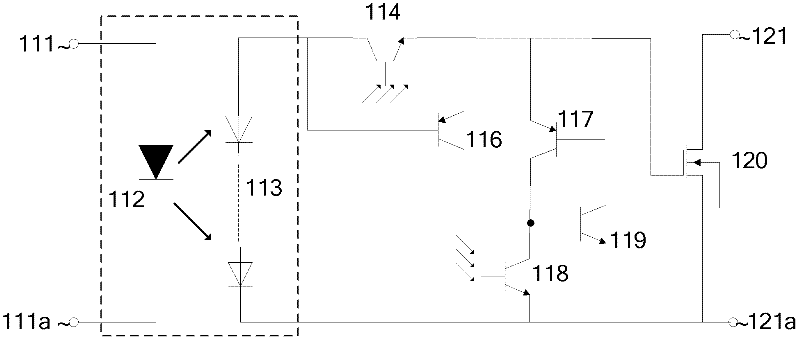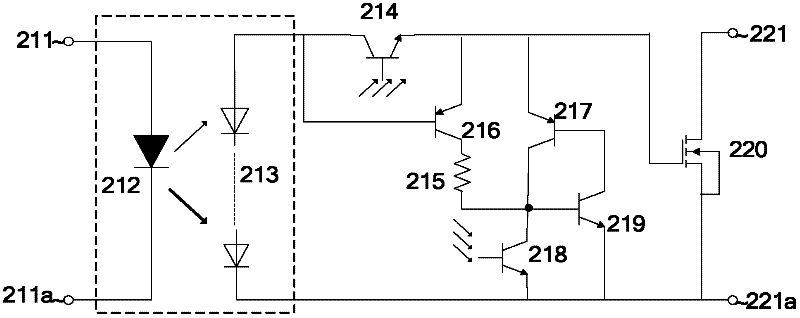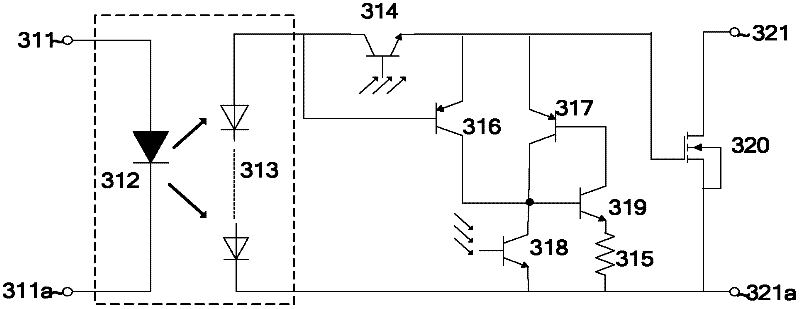Solid-state relay
A relay and collector technology, applied in the design field of solid state relays, can solve the problems of insufficient control, poor anti-interference ability, increased chip area and wiring difficulty, etc., to avoid misdirection, strong anti-interference ability, and increased area.
- Summary
- Abstract
- Description
- Claims
- Application Information
AI Technical Summary
Problems solved by technology
Method used
Image
Examples
Embodiment 1
[0030] An embodiment of the solid state relay according to the present invention is as follows: figure 1 shown in Example 1. Specifically, it includes a light-emitting element 112 connected between the relay input terminals 111 and 111a;
[0031] A photovoltaic diode array 113 that generates photovoltaic output when coupled with the light signal of the light-emitting element;
[0032] A normally-on metal oxide field effect transistor 120 connected between the output terminals of the relay;
[0033] Also includes,
[0034] An accelerated charging circuit composed of phototransistors 114, wherein the emitter of the phototransistor 114 is connected to the gate of the output normally-on metal oxide field effect transistor 120, and the collector is connected to the first end of the photovoltaic diode array 113;
[0035] An acceleration discharge circuit composed of two PNP triodes, an NPN triode 119 and a phototransistor 118, wherein the two PNP triodes are specifically the firs...
Embodiment 2
[0040] like figure 2 As shown, as a preferred mode of the first embodiment, the relay further includes a resistor 215, wherein the resistor 215 is connected between the collector of the first PNP transistor 216 and the collector of the second PNP transistor 217. Here, the introduction of the resistor 215 can reduce the probability of mis-conduction of the trigger current caused by the voltage fluctuation of the output terminal, and the size of the resistor 215 determines the size of the current triggered by the first PNP transistor 216 . For the specific working process, refer to Embodiment 1.
Embodiment 3
[0042] like image 3 As shown, as another preferred mode of the first embodiment, here, the relay further includes a resistor 315 , and the resistor 315 is connected between the emitter of the NPN transistor 319 and the emitter of the phototransistor 318 . This change can reduce the false turn-on, and at the same time, the impedance of the channel becomes larger during the discharge, so that the slope of the falling edge becomes slower, which improves the anti-noise capability. The specific working process can also refer to Embodiment 1.
PUM
 Login to View More
Login to View More Abstract
Description
Claims
Application Information
 Login to View More
Login to View More - R&D
- Intellectual Property
- Life Sciences
- Materials
- Tech Scout
- Unparalleled Data Quality
- Higher Quality Content
- 60% Fewer Hallucinations
Browse by: Latest US Patents, China's latest patents, Technical Efficacy Thesaurus, Application Domain, Technology Topic, Popular Technical Reports.
© 2025 PatSnap. All rights reserved.Legal|Privacy policy|Modern Slavery Act Transparency Statement|Sitemap|About US| Contact US: help@patsnap.com



